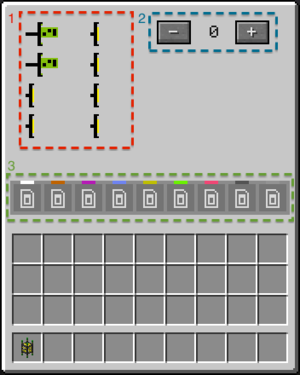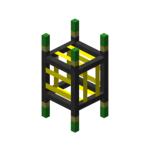Routed Crafting Pipe: Difference between revisions
Acesoyster (talk | contribs) |
No edit summary |
||
| Line 2: | Line 2: | ||
|image=Routed Crafting pipe 256.png | |image=Routed Crafting pipe 256.png | ||
|invimage=Routed Crafting pipe | |invimage=Routed Crafting pipe | ||
|type=Multipart Block | |type=Multipart Block | ||
|gravity=No | |gravity=No | ||
|transparent=Yes | |transparent=Yes | ||
| Line 9: | Line 9: | ||
|renewable=Yes | |renewable=Yes | ||
|availability=Survival | |availability=Survival | ||
|firstver=v4.0 | |firstver=v4.2.0 (beta) | ||
|drops=Itself <br/> Traveling items (0 - ∞) | |||
}} | }} | ||
'''Routed Crafting pipes''' are a type of [[Pipe#Classifications|routed pipe]] that allows items to be actively crafted when they are [[Routed Pipe Networks#Pull Routing|requested]]. | |||
== Obtaining == | == Obtaining == | ||
| Line 24: | Line 27: | ||
== Usage == | == Usage == | ||
Routed Crafting pipes are simply pipes that are an intelligent combination of [[Routed Pipe Networks#Types of routers|requesters and broadcasters]] that work together to craft items when they are being requested. | |||
Through a [[Routed Request pipe|request pipe]], items being "broadcasted" from a crafting pipe will have a count of zero (provided that that item is not also being broadcasted from somewhere else). This means that when that item is requested, it will look to the crafting pipe that makes it. The crafting pipe, in turn, will start making its own set of requests to create the item, and so on until all the ingredients are pulled. | |||
Extra items that reside from crafting (i.e. requesting 3 out of 4 of the crafted [[Wooden Plank|wooden planks]]) are forcibly extracted and [[Routed Pipe Networks#Push Routing|pushed]] into the network. If that fails, the items will wander around, so its important to have SOME place where overflow can go. | |||
Crafting pipes can have up to 8 [[Item Crafting Chip|crafting chips]] which store data on items going in vs items coming out. The network uses complex mathematics to resolve what needs to be requested based on this. | |||
Items being extracted after crafting will always respect ISidedInventory on the side the crafting pipe is attached. However, the side of input can be changed by using [[Routed Extension pipe|extension pipes]]. A crafting pipe can be linked with up to 9 different extension pipes. Afterwards, a crafting chip can associate a particular ingredient with a color. | |||
=== GUI === | |||
[[File:craftpipegui.png|left|thumb|300px|Gui of an Interface Pipe|link=]] | |||
1) '''Chip slots''' - These 8 slots accept [[Item Crafting Chip |crafting chips]]. They must be configured, or they won't be accepted. | |||
2) '''Priority''' - This is the priority for all crafting results. However, each job can have a unique priority configured from inside the crafting chip. | |||
3) '''Extension configuration''' - These 9 slots can hold [[Data Card|data cards]] that have been written to by [[Routed Extension pipe|extension pipes]]. This will associate an extension pipe with a color. This is usable by ingredients in the crafting chip. | |||
<br/><br/><br/><br/><br/><br/><br/><br/><br/><br/><br/><br/><br/><br/><br/> | |||
==History== | ==History== | ||
| Line 41: | Line 53: | ||
! '''Changes''' | ! '''Changes''' | ||
|- | |- | ||
| v4. | | v4.2.0 (beta) | ||
| Added the Routed Crafting pipe. | | Added the Routed Crafting pipe. | ||
|} | |} | ||
== Issues == | |||
{{Issues}} | |||
Revision as of 04:47, 26 February 2014
| Type |
Multipart Block |
|---|---|
| Physics |
No |
| Transparency |
Yes |
| Luminance |
? |
| Blast resistance | |
| Tool |
Any tool |
| Renewable |
Yes |
| Stackable |
Yes (64) |
| Flammable |
No |
| Availability |
Survival |
| First appearance | |
| Drops |
Itself |
| Name |
routed_crafting_pipe |
Routed Crafting pipes are a type of routed pipe that allows items to be actively crafted when they are requested.
Obtaining
Crafting
Lua error: callParserFunction: function "#dplvar" was not found.
Usage
Routed Crafting pipes are simply pipes that are an intelligent combination of requesters and broadcasters that work together to craft items when they are being requested.
Through a request pipe, items being "broadcasted" from a crafting pipe will have a count of zero (provided that that item is not also being broadcasted from somewhere else). This means that when that item is requested, it will look to the crafting pipe that makes it. The crafting pipe, in turn, will start making its own set of requests to create the item, and so on until all the ingredients are pulled.
Extra items that reside from crafting (i.e. requesting 3 out of 4 of the crafted wooden planks) are forcibly extracted and pushed into the network. If that fails, the items will wander around, so its important to have SOME place where overflow can go.
Crafting pipes can have up to 8 crafting chips which store data on items going in vs items coming out. The network uses complex mathematics to resolve what needs to be requested based on this.
Items being extracted after crafting will always respect ISidedInventory on the side the crafting pipe is attached. However, the side of input can be changed by using extension pipes. A crafting pipe can be linked with up to 9 different extension pipes. Afterwards, a crafting chip can associate a particular ingredient with a color.
GUI

1) Chip slots - These 8 slots accept crafting chips. They must be configured, or they won't be accepted.
2) Priority - This is the priority for all crafting results. However, each job can have a unique priority configured from inside the crafting chip.
3) Extension configuration - These 9 slots can hold data cards that have been written to by extension pipes. This will associate an extension pipe with a color. This is usable by ingredients in the crafting chip.
History
| Version | Changes |
|---|---|
| v4.2.0 (beta) | Added the Routed Crafting pipe. |
Issues
Issues pertaining to "Routed Crafting Pipe" are maintained on the ProjectRed Github page. Report issues there.


